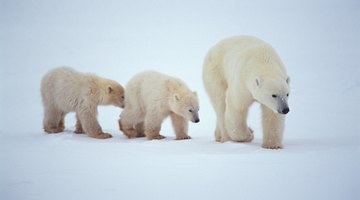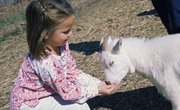Not many preschoolers can experience the icy environment of the Arctic zone first hand. But through Arctic-themed music, movement, game and craft activities, you can simulate the sights and sounds of the snowy biome and wildlife right in the safety and warmth of your own home. Bring the snow, polar bears, walruses, whales, Arctic hares, wolves and foxes to life with pretend play that expends your preschooler's abundant supply of energy -- and cap the fun with Arctic-inspired snacks.
Music and Movement
Any activity that inspires and encourages your little one's desire to be in motion will capture and hold his attention far better than a sit-still-and-listen activity. Recite rhymes about snow or polar bears with accompanying motions. For example, Twiggle Magazine suggests, "Polar bear, polar bear, twirl around. Polar bear, polar bear, make no sound. Polar bear, polar bear, dance on your toes. Polar bear, polar bear, touch your nose." Put on a classical music selection such as Vivaldi's "Winter" and do a snowflake dance, twirling and floating to the music like you're snowflakes. Or try singing and dancing to the "Snowy Pokey" using lines such as, "You put your right mitten in, you put your right mitten out."
Games
Even if you live in a tropical climate and your child is unlikely to see snow anywhere near home, she can experience the fun of a snowball fight. Whether the weather is too hot for snow or too frigid to let your preschooler outdoors safely, crumple old newspapers or recycled paper scraps into balls or ball up old socks for an indoor snowball fight to entertain your little tyke and a bevy of friends or siblings and family members. An Arctic "fishing" game lets your child practice aiming and throwing. To play, decorate a large box or bucket with a polar bear, seal or walrus cutout. Also, cut several large fish out of heavy cardboard or poster board. Your child should try to "feed" the polar bear by tossing fish into the bucket. If you attach magnets to the backs of the fish, you can get double duty out of this game by covering the top of the box or bucket with aluminum foil and punching a hole through it for "ice" fishing. Give your child a magnetic fishing line to lower through the hole to try to catch the fish for dinner -- just like a polar bear.
Crafts
Patience, adult preparation and a simple contribution to the finished art work are the necessary ingredients to keep your young child interested in, and enjoying, a craft project. Tearing white paper into free-form shapes and gluing them on a blue background to form snowflakes or polar animals gives your preschooler practice with developing motor skills and imagination at the same time. Put clean socks on your child's hands to give him the feel of what it's like for many polar animals that have no fingers. Squirt a moderate amount of paint onto a paper plate and give your little one a large piece of paper on which he can paint using his sock gloves. An alternative is to let your child "paint" free-form with whipped cream to create winter pictures. If you can't build a snowman out of real snow, cut out white circles to build one, no matter the weather. Help your child glue the circles into a snowman shape on a blue or black background. Cover the snowman with glue and sprinkle with coconut.
Snacks
After expending all that energy on Arctic games and songs, your growing child could benefit from the recharge of Arctic-themed snacks. Allowing her to help create the snack, gives her a vested interest in eating it with gusto -- and sharing it with you. One idea is to spread cottage cheese, vanilla yogurt or cream cheese on a rice cake or sugar cookie. Turn this base into a polar bear face by adding raisin eyes, an Oreo mouth and banana slices as ears. Another preschool-friendly treat that appeals to a young child's propensity to play with her food is to thread large and small marshmallows on toothpicks in the shape of a polar bear. Use white icing where necessary to "glue" pieces together. A white jellybean half, M&Ms and thin strips of black licorice can serve as the nose, the eyes and ears.
Related Articles
References
Resources
Writer Bio
Tamara Christine has written more than 900 articles for a variety of clients since 2010. She holds a Bachelor of Arts in applied linguistics and an elementary teaching license. Additionally, she completed a course in digital journalism in 2014. She has more than 10 years experience teaching and gardening.











